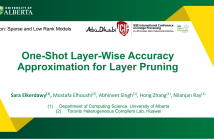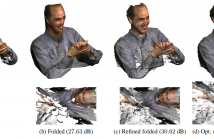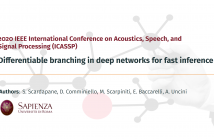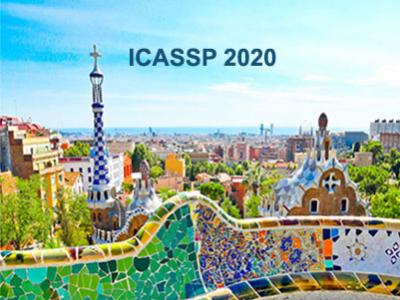
- Read more about GLAUCOMA DETECTION FROM RAW CIRCUMPAPILLARY OCT IMAGES USING FULLY CONVOLUTIONAL NEURAL NETWORKS
- Log in to post comments
- Categories:
 32 Views
32 Views
- Read more about One-Shot Layer-Wise Accuracy Approximation for Layer Pruning
- Log in to post comments
Recent advances in neural networks pruning have made it possible to remove a large number of filters without any perceptible drop in accuracy. However, the gain in speed depends on the number of filters per layer. In this paper, we propose a one-shot layer-wise proxy classifier to estimate layer importance that in turn allows us to prune a whole layer. In contrast to existing filter pruning methods which attempt to reduce the layer width of a dense model, our method reduces its depth and can thus guarantee inference speed up.
- Categories:
 65 Views
65 Views
- Read more about MULTI-SCALE EXPLAINABLE FEATURE LEARNING FOR PATHOLOGICAL IMAGE ANALYSIS USING CONVOLUTIONAL NEURAL NETWORKS
- 1 comment
- Log in to post comments
- Categories:
 27 Views
27 Views
Existing techniques to compress point cloud attributes leverage either geometric or video-based compression tools. We explore a radically different approach inspired by recent advances in point cloud representation learning. Point clouds can be interpreted as 2D manifolds in 3D space. Specifically, we fold a 2D grid onto a point cloud and we map attributes from the point cloud onto the folded 2D grid using a novel optimized mapping method. This mapping results in an image, which opens a way to apply existing image processing techniques on point cloud attributes.
- Categories:
 49 Views
49 Views
- Read more about JOINT IMAGE SUPER-RESOLUTION VIA RECURRENT CONVOLUTIONAL NEURAL NETWORKS WITH COUPLED SPARSE PRIORS
- Log in to post comments
- Categories:
 8 Views
8 Views
- Read more about Kernelized Dense Layers For Facial Expression Recognition
- 1 comment
- Log in to post comments
Fully connected layer is an essential component of Convolutional Neural Networks (CNNs), which demonstrates its efficiency in computer vision tasks. The CNN process usually starts with convolution and pooling layers that first break down the input images into features, and then analyze them independently. The result of this process feeds into a fully connected neural network structure which drives the final classification decision. In this paper, we propose a Kernelized Dense Layer (KDL) which captures higher order feature interactions instead of conventional linear relations.
- Categories:
 14 Views
14 Views
- Read more about CDVA/VCM: LANGUAGE FOR INTELLIGENT AND AUTONOMOUS VEHICLES
- 1 comment
- Log in to post comments
Intelligent transportation is a complex system that involves the interaction of connected technologies, including Smart Sensors, Intelligent and Autonomous Vehicles, High Precision Maps, and 5G. The coordination of all these machines mandates a common language that serves as a protocol for intelligent machines to communicate. International standards serve as the global protocol to satisfy industry needs at the product level. MPEG-CDVA is the official ISO standard for search and retrieval applications by providing Compact Descriptors for Video Analysis (CDVA).
- Categories:
 119 Views
119 Views
- Read more about RADAR+RGB Fusion for Robust Object Detection in Autonomous Vehicles
- Log in to post comments
This paper presents two variations of architecture referred to as RANet and BIRANet. The proposed architecture aims to use radar signal data along with RGB camera images to form a robust detection network that works efficiently, even in variable lighting and weather conditions such as rain, dust, fog, and others. First, radar information is fused in the feature extractor network. Second, radar points are used to generate guided anchors. Third, a method is proposed to improve region proposal network targets.
- Categories:
 41 Views
41 Views
- Read more about Differentiable Branching in Deep Networks for Fast Inference
- Log in to post comments
In this paper, we consider the design of deep neural networks augmented with multiple auxiliary classifiers departing from the main (backbone) network. These classifiers can be used to perform early-exit from the network at various layers, making them convenient for energy-constrained applications such as IoT, embedded devices, or Fog computing. However, designing an optimized early-exit strategy is a difficult task, generally requiring a large amount of manual fine-tuning.
- Categories:
 113 Views
113 Views
- Read more about Spiking neural networks trained with backpropagation for low power neuromorphic implementation of voice activity detection
- Log in to post comments
Recent advances in Voice Activity Detection (VAD) are driven by artificial and Recurrent Neural Networks (RNNs), however, using a VAD system in battery-operated devices requires further power efficiency. This can be achieved by neuromorphic hardware, which enables Spiking Neural Networks (SNNs) to perform inference at very low energy consumption. Spiking networks are characterized by their ability to process information efficiently, in a sparse cascade of binary events in time called spikes.
- Categories:
 118 Views
118 Views